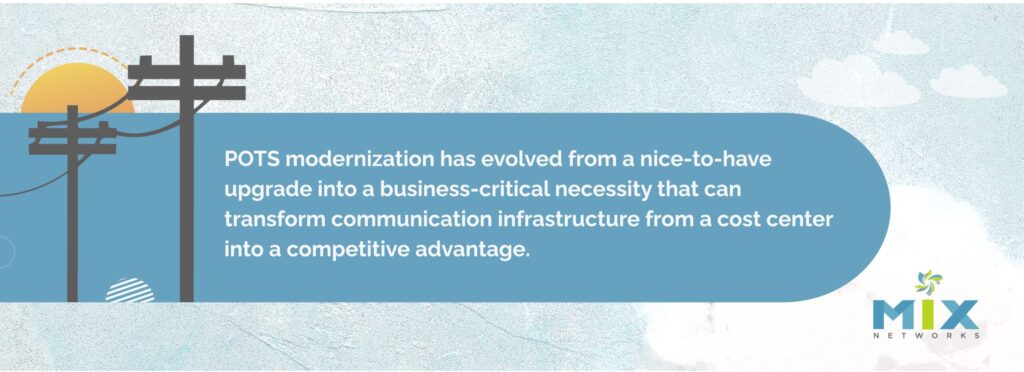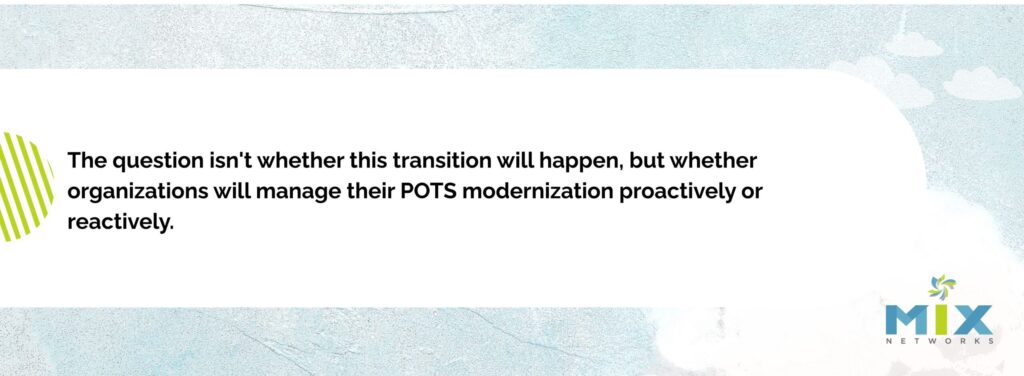The telecommunications landscape is undergoing a fundamental transformation that demands immediate attention from business leaders. Organizations still relying on traditional Plain Old Telephone Service (POTS) aren’t just missing out on modern conveniences—they’re exposing themselves to escalating risks that threaten operational continuity, regulatory compliance, and competitive positioning. POTS modernization has evolved from a nice-to-have upgrade into a business-critical necessity that can transform communication infrastructure from a cost center into a competitive advantage.
Why POTS Modernization is Essential: The Deteriorating Foundation
The most immediate driver for POTS modernization is the literal crumbling of the infrastructure beneath traditional communications. Copper networks installed decades ago are showing unmistakable signs of decline, with failure rates climbing steadily while repair times stretch longer. These aren’t minor inconveniences—they’re operational disruptions that cascade through entire organizations, affecting everything from customer service to internal coordination.
This deterioration is compounded by a strategic shift among major telecommunications providers. Carriers aren’t simply neglecting their copper networks; they’re actively retiring them in favor of IP-based services. This carrier abandonment puts organizations delaying POTS modernization in an increasingly precarious position, facing the prospect of forced migration under terms dictated by providers eager to complete their infrastructure transitions. The question isn’t whether this transition will happen, but whether organizations will manage their POTS modernization proactively or reactively.
Environmental vulnerabilities add another layer of urgency to POTS modernization initiatives. Copper lines demonstrate remarkable susceptibility to weather damage, with underground cables flooding during heavy rains and overhead lines failing during storms and ice accumulation. As weather patterns become more extreme, these vulnerabilities translate into more frequent and longer-lasting communication outages. The rising threat of copper theft compounds these physical security concerns, potentially leaving businesses without essential services for days or weeks during critical periods.
Navigating Regulatory Requirements
While infrastructure concerns create immediate operational challenges, regulatory requirements present equally pressing strategic considerations for POTS modernization planning. The compliance landscape increasingly favors modern communication solutions, creating both risks for organizations clinging to legacy systems and opportunities for those embracing modernization.
Traditional POTS systems provide reliable location information tied to physical addresses, but modern VoIP systems can deliver enhanced location details that emergency services increasingly value—such as specific building floors, rooms, or campus locations—when properly configured to meet federal dispatchable location requirements. Successful POTS modernization ensures organizations can meet these enhanced E911 requirements while potentially improving emergency response effectiveness.
The Americans with Disabilities Act compliance landscape also demonstrates clear advantages for POTS modernization initiatives. Modern VoIP systems incorporate accessibility features for hearing-impaired users that traditional systems struggle to match, reducing legal exposure while improving service quality for all users. This improvement in compliance posture extends beyond telecommunications regulations into industry-specific requirements that affect healthcare, financial services, and other heavily regulated sectors.
Business Continuity Through POTS Modernization
The COVID-19 pandemic provided an unexpected but definitive test of communication systems’ role in organizational resilience, highlighting the critical importance of POTS modernization. This crisis revealed a stark divide between organizations equipped with modern, cloud-based communication platforms and those dependent on traditional POTS systems. While the former adapted quickly to remote work requirements and maintained operational continuity, the latter struggled to maintain basic communication capabilities outside their physical locations.
This disparity highlights a fundamental architectural advantage that drives POTS modernization decisions: geographic redundancy that eliminates single points of failure through automatic service distribution across multiple data centers. During natural disasters, power outages, or other localized disruptions, this redundancy proves invaluable in maintaining business operations. Traditional POTS systems, tied to physical infrastructure, require complete restoration before communication services resume, while modernized systems enable rapid service restoration at alternate locations.
These business continuity advantages extend beyond crisis response into day-to-day operational resilience, creating a foundation for sustained competitive advantage that compounds over time—making POTS modernization a strategic investment rather than a simple technology upgrade.
The Financial Case for POTS Modernization
Beyond operational and compliance considerations, the financial implications of POTS modernization demand careful analysis. Traditional telecommunications billing models introduce unpredictability that modern business planning struggles to accommodate, with unexpected charges and bill spikes creating budget uncertainty that hosted solutions eliminate through predictable monthly pricing structures.
This financial predictability extends to technology refresh cycles, where traditional systems require periodic capital expenditures for equipment updates and maintenance, often arriving at inconvenient times. POTS modernization through hosted solutions includes automatic updates and technology refresh in service models, converting unpredictable capital expenses into manageable operational costs while ensuring access to the latest capabilities.
Scalability considerations present another compelling financial argument for POTS modernization. Traditional systems force organizations to choose between over-provisioning expensive lines or risking capacity constraints during growth periods. Modernized solutions scale dynamically, eliminating both over-investment risks and capacity limitations while supporting business growth without infrastructure constraints.
From Cost Center to Strategic Asset
The most compelling argument for POTS modernization lies not in risk mitigation but in value creation. Modern communication infrastructure provides the foundation for comprehensive digital transformation initiatives, enabling organizations to modernize operations holistically rather than piecemeal. This transformation potential represents a strategic opportunity that extends far beyond simple technology upgrades.
Contemporary systems generate valuable business intelligence through built-in analytics capabilities, transforming communication expenses from cost centers into revenue-generating assets through POTS modernization. Data about communication patterns, customer interactions, and operational efficiency becomes actionable intelligence that drives business improvement across multiple functions.
Integration capabilities through open APIs create additional value by enabling seamless connections with CRM systems, help desk software, and other business applications. These integrations generate operational efficiencies and customer service improvements that traditional systems cannot support, creating compound benefits that increase over time as organizations fully leverage their POTS modernization investment.
Quantifying POTS Modernization ROI
The business case for POTS modernization becomes even more compelling when benefits are quantified. Modern solutions typically achieve 99.9% uptime compared to 95-98% for traditional POTS, translating directly into reduced business disruption and improved customer satisfaction. Some insurance providers recognize these improvements through premium discounts for organizations completing POTS modernization projects that include modern emergency communication systems.
Built-in compliance features eliminate the need for separate recording and monitoring systems, reducing both capital expenses and ongoing operational complexity. This compliance cost avoidance represents quantifiable savings that improve POTS modernization return on investment while reducing operational burden.
Perhaps most significantly, the opportunity costs of delaying POTS modernization compound over time, affecting organizational agility, competitive positioning, and growth potential in ways that extend far beyond monthly service charges.
The Strategic Choice Ahead
The decision between maintaining traditional POTS and pursuing POTS modernization represents more than a technology choice—it’s a strategic decision about organizational resilience, competitive positioning, and future operational capabilities. While risk mitigation provides compelling justification for modernization, the strategic opportunities created by contemporary communication platforms offer even greater long-term value.
Organizations that approach POTS modernization as an investment in their future operational capabilities, rather than simply a risk mitigation expense, position themselves to capitalize on emerging technologies, evolving work patterns, and changing customer expectations. In today’s business environment, where communication infrastructure increasingly determines operational agility, the true cost of delaying extends far beyond monthly service charges to encompass opportunity costs that compound over time.
Your POTS Modernization Solution: POTS IN A BOX
For organizations ready to embrace POTS modernization while minimizing disruption, POTS IN A BOX technology offers an ideal bridge from legacy systems to modern communications. This innovative approach converts traditional analog phone lines to digital signals at the premises level, enabling businesses to maintain their existing phone equipment and numbers while gaining access to the reliability, scalability, and advanced features of modern IP-based networks.
POTS IN A BOX solutions address the core challenges that drive POTS modernization initiatives. They eliminate dependence on deteriorating copper infrastructure by routing calls over robust fiber and cellular networks, ensuring consistent service quality and reduced downtime. The technology provides automatic failover capabilities across multiple connection types, delivering the geographic redundancy and business continuity advantages that modern organizations require.
From a compliance perspective, these solutions enable enhanced E911 capabilities with dispatchable location information while maintaining the familiar operation that staff members already understand. Organizations can implement the technology without retraining employees or replacing existing phone equipment, dramatically reducing implementation complexity and costs.
Perhaps most importantly, POTS IN A BOX serves as a strategic stepping stone rather than a final destination in your POTS modernization journey. It provides immediate risk mitigation and operational improvements while positioning organizations to adopt additional unified communications features over time. This phased approach enables businesses to realize benefits immediately while planning for future enhancements that align with their digital transformation objectives.
Take Action on Your POTS Modernization Today
The choice is clear: organizations can wait for circumstances to force expensive, reactive migrations, or they can take control of their communication infrastructure evolution through proven solutions like POTS IN A BOX. Those who choose the proactive path will not only solve their immediate POTS challenges but also establish the foundation for sustained competitive advantage in an increasingly connected business environment.
Don’t let deteriorating infrastructure, regulatory changes, or competitive pressures force your hand. Start your journey today with a solution that bridges the gap between legacy reliability and modern capabilities. Contact us to learn how POTS IN A BOX can transform your communication infrastructure while protecting your existing investment in phone equipment and staff training.










